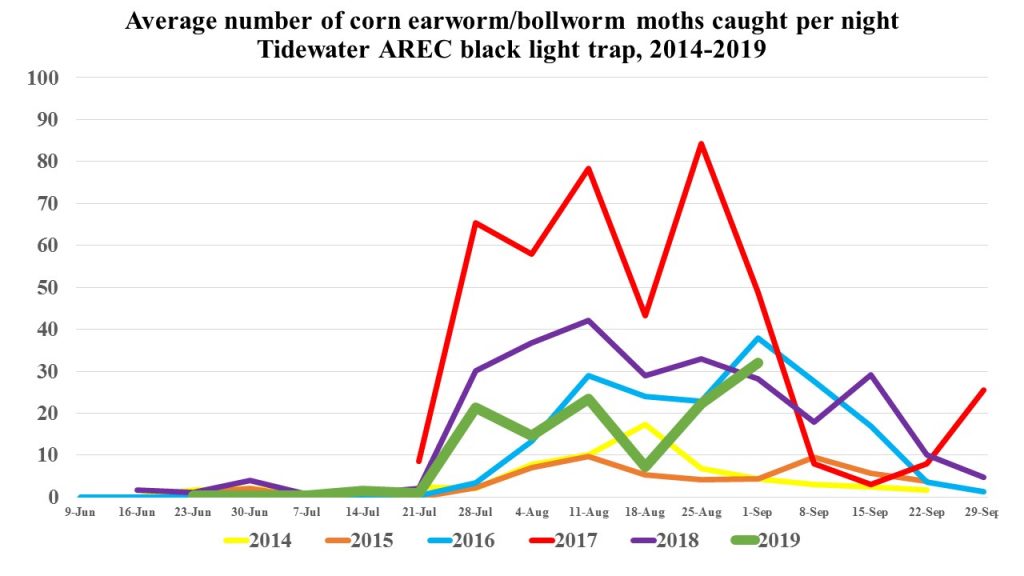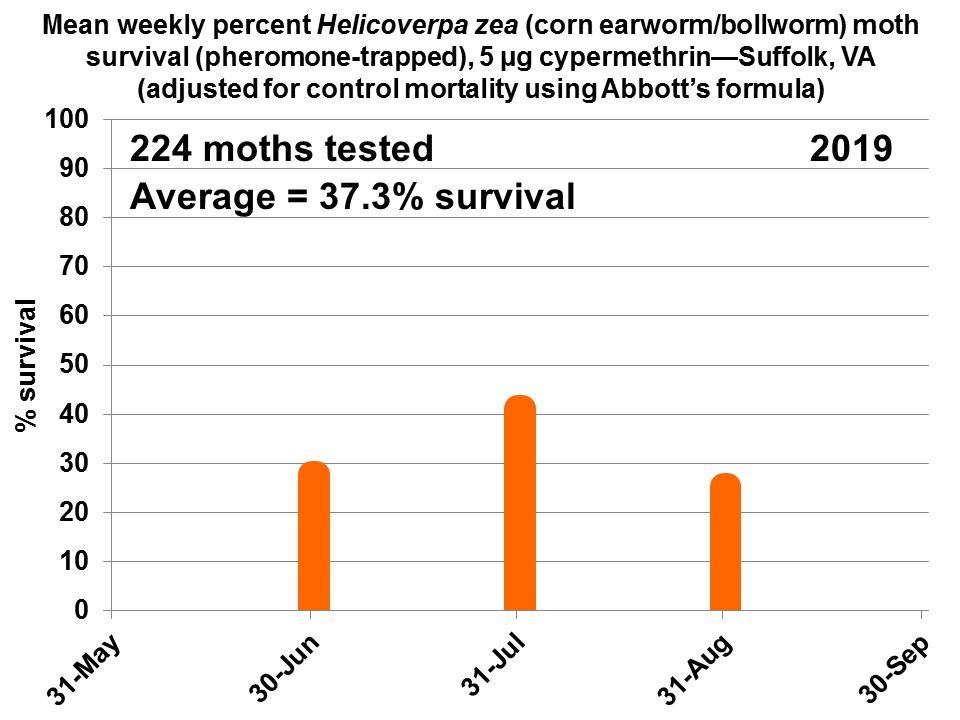Average nightly corn earworm/bollworm moth black light trap captures for this week were: Dinwiddie=48; Greensville=47; Hanover=2.5; Prince George-Templeton=18; Prince George-Disputanta=5; Southampton=13; Suffolk=41. Here is the Table
Author Archives: Sean Malone
Corn earworm report–August 20, 2020
Average nightly corn earworm/bollworm moth black light trap captures for this week were: Dinwiddie=51; Greensville=9; Hanover=3 (first week with more than 0.5 per night); Prince George-Templeton=12; Prince George-Disputanta=3; Southampton=5; Suffolk=17. Here is the Table. At just over 200 vial tests conducted, corn earworm moth survival is 39%.
Corn earworm report–August 13, 2020
Average nightly corn earworm/bollworm moth black light trap captures for this week were: Dinwiddie = 26; Greensville =4; Prince George-Templeton = 9; Prince George-Disputanta = 6; Southampton = 8; Suffolk = 23. Thanks to our Agents and Growers for their efforts. Here is the data table
Sally Taylor and her entomology program sampled a Cotton Incorporated sponsored planting date experiment today at the Tidewater AREC in Suffolk, VA. We found 2 to 6.5% bollworm-injured bolls in conventional (non-genetically protected against bollworm) cotton. In our Virginia Soybean Board experiment with maturity groups 4 and 5 full-season soybean (beginning pod growth stage), we had 2.3 to 5 corn earworm larvae and up to 3 soybean looper larvae per 15 sweeps.
Corn earworm update for August 6, 2020
Average nightly moth captures for this week were: Greensville =10; Prince George-Templeton = 3; Prince George-Disputanta = 7; Suffolk = 21. Here is the data table
Corn earworm update for July 30, 2020
Black light trap nightly averages for corn earworm/bollworm moths this week in Virginia were: Greensville = 35.6; Prince George-Templeton = 1.0; Prince George-Disputanta = 3.3; Southampton = 2.0; Suffolk = 17.1 (all reports were higher than last week). Thanks to our Agents for their reports.
Resistance monitoring of corn earworm/bollworm using adult vial tests now has 50% of moths surviving the 24-hour exposure to the pyrethroid, cypermethrin at the 5 microgram/vial rate (76 vials tested to date, collected from Suffolk).
Corn earworm moth report for July 23, 2020
Prior to this week, corn earworm/bollworm moth counts have been low in southeast Virginia black light traps. For this week (July 17-23), average nightly catches of moths were: Greensville = 7.4; Prince George-Templeton = 0.3; Prince George-Disputanta = 0.7; Southampton = 1.5; Suffolk = 7.4. Thanks to the Virginia Cooperative Extension Agents who are operating traps this season.
We have tested 47 corn earworm/bollworm moths since June 23, 2020 in our pyrethroid resistance monitoring program. Moths are captured in pheromone traps and are exposed to 5 micrograms of cypermethrin inside a glass vial for 24 hours, then rated as dead/down/alive. Untreated controls (in acetone-only treated vials) are also evaluated to correct for control mortality. The average for the past month is 43% moth survival. High survival rates indicate an increased chance of pyrethroid control issues and the need to consider alternative chemistries if a spray is needed.
In a non-Bt corn experiment planted on April 9 at our research farm in Suffolk, VA, we had large corn earworm larvae in the ears last week. Now they have exited the ears and are pupating in the soil. It takes about 10 days for the moths to emerge–this flight out of corn is the one that we are concerned with in crops such as soybean, cotton, peanuts, and vegetables–the moths want to lay eggs on a good food source for their larvae. Please check back with the Advisory for more pest updates and recommendations.
Corn earworm update for September 5, 2019
Average nightly black light trap captures of corn earworm moths this week were: Chesapeake=33; Greensville=13; Southampton=10; Suffolk=27. Hanover had 12 per night if averaged over the past 2 nights, but 3 if averaged over the entire week. Here is the table:
In our corn earworm pyrethroid resistance monitoring experiment (adult vial tests), the seasonal average is 36% survival to a 24-hour exposure of 5 micrograms of cypermethrin per vial.
Corn earworm update for August 29, 2019
Nightly corn earworm/bollworm moth averages for reporting black light trap stations this week were: Greensville=22; Prince George (Templeton)=12; Prince George (Disputanta)=10; Southampton=13; Suffolk=32. Please see the link to the table below and also compare this year’s Suffolk, VA numbers to the past several years.

I have seen a large number of corn earworm moths in our soybean at the Tidewater Agricultural Research & Extension Center in Suffolk this week. Remember to scout for larvae and use the threshold calculator for soybean: https://www.ces.ncsu.edu/wp-content/uploads/2017/08/CEW-calculator-v0.006.html
Our pheromone trap catches at Suffolk have also increased and we were able to conduct more adult vial tests for resistance monitoring using the pyrethroid cypermethrin. The average survival for this season is now 37%.

Black light trap counts for August 22, 2019
Nightly captures of corn earworm (bollworm) moths in area black light traps greatly increased in Greensville this week (averaging 54 per night). Other reporting stations averaged from 6-7 per night in Prince George, 8 in Hanover, 16 in Chesapeake, 16 in Warsaw, and 22 in Suffolk. Please see the table here:
Corn earworm/bollworm update for August 15, 2019
Moth numbers from reporting black light trap stations dipped somewhat from the highs of last week; please see the table below for more details. However, what this does mean for soybeans that are in the flowering stage or later is to scout for corn earworm larvae and use the online threshold calculator https://www.ces.ncsu.edu/wp-content/uploads/2017/08/CEW-calculator-v0.006.html with information specific to your fields. Please keep scouting in cotton, peanut, and other crops, too. Here is the black light table:
